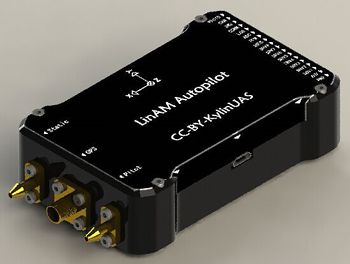Difference between revisions of "LinAM V4"
| Line 4: | Line 4: | ||
|} | |} | ||
<div style="float: right; width: 65%"> | <div style="float: right; width: 65%"> | ||
[[ | [[Image:LinAM V4 BOX1.jpeg|350px|LinAM V4 BOX1]] | ||
[[Image:LinAM V4 | [[Image:LinAM V4 BOX2.png|350px|LinAM V4 BOX2]] | ||
</div> | </div> | ||
__TOC__ | __TOC__ | ||
Revision as of 20:50, 4 July 2015
LinAM V4
Editing...
Overview
LinAM V4 is based on the 64 pins STM32F405RGT6 Cortex M4 168MHz processor featuring a Floating point unit (FPU), up to 192k of RAM and 1024k of FLASH.
- STM32 microcontroller datasheet with 1024kB flash and up to 192kB RAM
- 9 DOF integrated IMU based: ADXRS620BBGZ Gyro sensor and MXR9150MZ Accelerometer with 16 bit ADC ,HMC5983 magnet field sensor.
- high precision barometer/altimeter MS5611-01BA03(I2C).
- Onboard U-Blox GPS MAX-M8Q.
- Onboard differential pressure sensor MPXV5004DP (for airspeed) with 16 bit ADC
- 2 x 3.3V TTL UART (5V tolerant)
- 1 x USB : DFU mode (download) or USB storage (direct access to MicroSD card)
- 8 x Servo PWM outputs
- 1 x R/C receiver PPM frame input
- 1 x R/C receiver serial input with inverter (Futaba S.BUS, Spektrum, etc.)
- 1 x I2C bus
- 1 x CAN bus
- SWD programming/debugging interface.
- 4 x Auxiliary I/O (General Purpose and/or ADC and/or servo PWM).
- 2 x isolated IO for camera control (POWER and SHUTTER).
- Up to 35V (8S LiPo) input power control unit
- Up to 2.5A load current on 5V line
- 1 x 5v/500mA power switch
- 4 x status LEDs
- 20 grams
- 65mm x 45mm
- 4 layers PCB design
- the box is 89mm x 51mm x 25mm
So, except for a Modem unit with the LinAM you have all necessary sensors for full features all in one Rotorcraft or Fixedwing solution.
Hardware Revision History
| Version # | Release Date | Release Notes |
|---|---|---|
| v1.00 | 07/2014 | Initial release of LinAM |
| v2.00 | 11/2014 | LinAM V2 |
| v3.00 | 02/2015 | LinAM V3 |
| v4.00 | 07/2015 | LinAM V4 |
Detailed Features
9 DOF IMU
- ADXRS620BBGZ Gyro sensor : quality acceleration sensor from Analog Device sensing solutions, it brings one of the best motion sensing performances and vibration immunities in it's class. It ensures much better flight stability and higher immunity to vibration noisy aircrafts.
- MXR9150MZ Accelerometer: quality acceleration sensor from Memsic sensing solutions, it brings one of the best motion sensing performances and vibration immunities in it's class. It ensures much better flight stability and higher immunity to vibration noisy aircrafts.
- HMC5983 magnet field sensor:
USB Modes
- usb plugged before autopilot is powered : enter DFU mode to be flashed
SWD: Serial Wire Debug
permits flash and source level debugging via swd part of cheap discovery card, or via more capable, fastest, more expensive probe like black magic probe
R/C Serial
In addition to the classic PPM input, that mostly require receiver modification, one pin of the R/C connector is routed to the MCU UART5 receive input through a controlled inverter.
This new feature allow direct connection (3 pin) of several brand off-the-shelf receivers without hardware modification or external encoder board.
- RX5_POL(PA8) = 0 => R/C serial (Rx5) is non-inverted : allow use standard polarity serial receivers (Spektrum, FlyElectric...)
- RX5_POL(PA8) = 1 => R/C serial (Rx5) is inverted : allow use of S.BUS protocol compatible receivers (Futaba, FrSky,...)
(see R/C Receivers and Radios page for serial compatible receiver)
Power Switch
5V power output pin on AUX connector ("5Vaux",#2) can be switched ON and OFF on demand using APSW (MCU GPIO output PB12).
- APSW(PA15) = 0 => 5V Aux OFF
- APSW(PA15) = 1 => 5V Aux ON (default)
The internal switch TPS2051B is designed to withstand 500mA continuous current and is short-circuit and thermally protected.
(see TPS2051B datasheet for recommended operation conditions)
Editing...
Pinout
Editing...
Pictures
Editing...
Programming
Editing...
LinAM autopilot can reprogrammed in two different ways:
- using the MCU native (embedded in rom) DFU USB bootloader over the on-board USB header (so pre-loading an "external" bootloader is useless)
- required hardware : usb cable with usb-mini connector
- required software : dfu_util tool (present in ubuntu repository)
- using the SWD (Serial Wire Debug) connector
- required hardware : usb cable with usb-mini connector, molex to 2.54mm pitch pin cable, swd part of a cheap stm32 evaluation board (any discovery board, start @ 8$)
- required software : st_flash and st_util, have to be compiled from source (https://github.com/texane/stlink)
Schematics
Editing...
Source code
Available in latest git master branch

